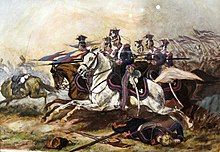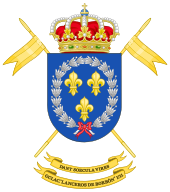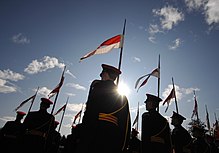Lancer

A lancer was a type of
17th-, 18th-, and 19th-century lancers

The lancer (Polish: ułan, German: Ulan, French: uhlan) had become a common sight in the majority of European, Ottoman, and Indian cavalry forces during this time, but, with the exception of the Ottoman troops, they increasingly discarded the heavy armour to give greater freedom of movement in combat. The Polish "winged" lancers were amongst the last European units to abandon their armour. There was debate over the value of the lance in mounted combat during the 17th and 18th centuries, with most armies having very few lancer units by the beginning of the 19th century.
However, during the
At the Battle of Waterloo, French lances were "nearly 3 metres (9.8 ft) long, weighed around 3 kilograms (6.6 lb), and had a steel point on a wooden staff," according to historian Alessandro Barbero. He adds that they were "terrifyingly efficient." Commander of the French 1st Corps, 4th Division General Durutte, who saw the battle from the high ground in front of Papelotte, would write later, "I had never before realized the great superiority of the lance over the sword."[2]
Although having substantial impact in the
Lancer equipment

Lancers typically wore a double-breasted jacket (
20th-century lancers

In 1914, lances were still being carried by regiments in the
The British cavalry lost the lance for all but ceremonial use in 1903, following the Second Boer War; but a conservative revaluation led to its reintroduction as an active service weapon from 1909 to 1928.[7][Note 1]
The French army did not have lancer regiments as such, but steel lances 2.97 meters (9.7 ft) in length were carried by the twenty-six dragoon regiments and some light cavalry units in 1914. The French had earlier tested the Indian bamboo lances used by the British cavalry, but had rated them as being too fragile for the shock of encounter.[8] The six Italian lancieri regiments[9] still in existence until 1920 carried the 1870 model of ashwood lance, noted for its balance and manageability.[10]

(11th Cavalry Regiment "Spain")
Prior to the outbreak of World War I, there had been controversy as to whether lances or sabres were the more effective armes blanche (i.e. mêlée weapons) for cavalry, but neither proved a match for modern firearms and/or artillery. Some armies continued to use lances throughout the war, but they seldom saw use on the Western Front after initial clashes in France and Belgium in 1914. On the Eastern Front, mounted cavalry still had a role and lances saw limited use by the Russian, German, and Austrian armies.[11]
During the 1920s and 1930s, the use of lances ceased for active service in most armies. The German cavalry retained the lance as a service weapon until 1927, as did the British cavalry until 1928. Some other armies retained lance-armed cavalry units for ceremonial purposes only. The Polish cavalry did not discard the lance as a weapon until 1934[12] or 1937[13] and continued to use it for training and ceremonial purposes until the outbreak of World War II.
Current lancer units


Some modern armored cavalry units are still designated as lancer regiments for historical and ceremonial reasons. There are examples in the armies of
Although not classified as lancers, the
The
The modern Italian Regiment "Lancieri di Montebello" (8th) parade detachments armed with the lances carried as combat weapons until 1920.
See also
Notes
- ^ For an illustration of a fully armed lancer, see Michael Chappell's "Men at Arms Series British Cavalry Equipment 1800–1941" illustration G 1.
References
- ISBN 0-7137-0575-2.
- ^ Barbero, pp. 161, 163.
- ^ p150, Volume 16, Encyclopædia Britannica, Eleventh Edition
- ^ Rodolfo Puletti, page 54, "I Lancieri di Milano 1859–1985", published by Editrice Militare Italiana 1985
- ISBN 978-0713411638
- ISBN 1-84176-303-9
- ISBN 978-1-4728-1618-4
- ^ Christian Tollet "Les Dragons 1914" Histoire & Collections 2009
- ^ Ronald Strom, page 154, "Great Regiments", SBN 297.17647.3, published by Weidenfeld and Nicolson, London 1969
- ^ Rodolfo Puletti, pages 54–55, "I Lancieri di Milano 1859–1985", published by Editrice Militare Italiana 1985
- ISBN 1-59048-256-5
- ISBN 0-85045-417-4
- ISBN 978-1-4728-1618-4
Sources
- Barbero, Alessandro, The Battle; A New History of Waterloo, Walker & Co., New York 2005,
- Chappell, Mike (2002). Men at Arms Series British Cavalry Equipment 1800–1941. Men–at–arms No. 138 (revised ed.). Oxford: Osprey Publishing. OCLC 48783714.
